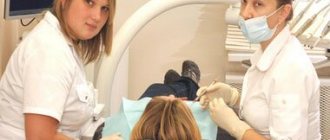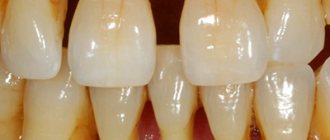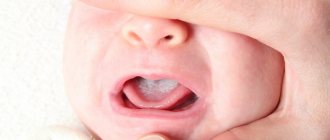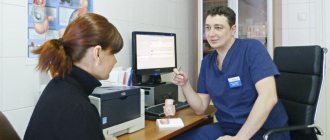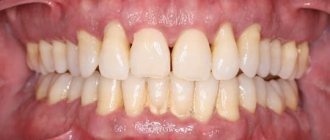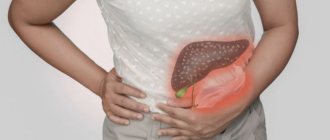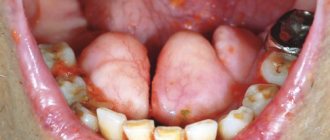How to cure periodontal disease forever?
Treatment of any disease begins with diagnosis. In the case of periodontal disease, which is often asymptomatic, the following procedures are performed to make a final diagnosis:
- examination of the oral cavity;
- probing of the gingival sulcus;
- X-ray examination (orthopantomography);
- biomicroscopy of the gums to determine the degree of microcirculation impairment.
The main factor confirming the presence of periodontal disease is a uniform decrease in the height of the interdental septa with alternating foci of osteosclerosis and osteoporosis in the deep parts of the alveolar process and the body of the jaw, as well as in other bones of the skeleton. As a rule, all these manifestations are displayed on an x-ray. The patient will also need additional consultation with a general practitioner and an endocrinologist to identify and treat metabolic disorders, diseases of the cardiovascular or endocrine systems, which often accompany the disease.
How to get rid of periodontal disease and finally prevent bone tissue destruction? Unfortunately, it is impossible to completely say goodbye to the disease. For this reason, treatment of dental periodontal disease is usually aimed at slowing down the process of periodontal dystrophy and preventing tooth loss, tissue inflammation and purulent bone damage.
Stages of pathology progression
The disease develops over the years without causing significant discomfort to the patient. Severe loosening and loss of teeth occurs on average 10 years after the onset of destructive processes.
There are 5 stages:
- The initial stage of periodontal disease is asymptomatic. At this stage, even during an examination in a clinic, it is difficult to identify the disease, but it is possible. The gums become lighter and lose their shine. Teeth sensitivity to sour and sweet foods increases slightly. An X-ray image shows a slight loss of alveolar bone. The interdental papillae become more rounded, normally triangular. Destructive processes can be reversed if the cause is identified and eliminated.
- At the first stage, changes in bone tissue are already obvious, but pronounced symptoms are still not observed. There may be itching, burning in the gums, slight exposure of the neck - up to 1.5 millimeters, a slight discrepancy of the teeth in the front row. The x-ray shows bone resorption (no more than one third). There are no abnormalities in the cortical plate. The teeth are motionless, well fixed in the socket. Therapeutic treatment and observation by a doctor every six months are required.
- At the second stage, the patient can already independently recognize the problem. The sensitivity of the teeth increases, a dull pain appears, itching in the gums, the neck is exposed by 5 millimeters, the discrepancy of the anterior dental units becomes more noticeable, and a pathological bite is formed. Visually you can see the border between the enamel and hard root tissue. X-rays show two-thirds bone resorption and severe changes in the alveolar process. Bone tissue becomes denser and chewing efficiency decreases. Complex treatment is required: therapy, physiotherapy, splinting. After therapeutic treatment, bone grafting is recommended.
- The third stage is characterized by high tooth sensitivity to hot, sour and cold foods, looseness, and severe discrepancy. Gum recession increases, the roots are exposed by more than half. An x-ray shows a decrease in the alveolar part of the jaw by a centimeter. At this stage, it is impossible not to notice the problem visually. When diagnosing, the doctor evaluates the appropriateness of therapy.
- At the fourth stage, the root part is exposed by two-thirds. The roots are held in the hole only by the tip. Teeth lose functionality and it is almost impossible to save them.
Treatment methods for periodontal disease
The development of the disease can be slowed down by treating periodontal disease with medications and carrying out the following procedures:
- professional hygiene for timely removal of dental plaque;
- splinting to normalize occlusal relationships;
- the use of drugs for periodontal disease, vitamins and agents to improve microcirculation in tissues (nicotinic acid, aloe extract, heparin);
- massage to strengthen gums during periodontal disease;
- grinding of teeth;
- prosthetics;
- darsonvalization of gums;
- filling erosions.
Modern methods
The most effective treatment for periodontal disease is based on the use of more modern methods, listed below:
- exposure to high pressure oxygen in hyperbaric chambers;
- ultrasonic device for the treatment of periodontal disease;
- local hypo- and hyperthermia;
- diadynamic currents;
- amplipulse therapy;
- electrophoresis;
- UHF therapy.
Which doctor treats periodontal disease? Most patients do not know the answer to this question. A doctor who treats periodontal disease is called a periodontist. Be sure to contact this specialist if you notice pale coloration and receding gums, increased tooth sensitivity, or a wedge-shaped defect. Where to treat periodontal disease? Of course, in a dental clinic.
Massage and gymnastics
Gum massage can be considered as an excellent aid that increases blood flow and lymph movement. Usually carried out after injections in order to quickly absorb the injected drug.
The massage is performed manually in the direction from the center of the jaw to its edges, or using a special apparatus. The procedure can be carried out independently, combined with the active rubbing of ready-made preparations - ointments or gels. The procedure stimulates blood circulation well and helps relieve discomfort such as pain or itching in the gums.
To avoid further injury to the gums and loosening of the teeth, massage is carried out with careful movements of the fingers, with minimal pressure.
Important. Before you prescribe a massage for yourself, be sure to consult with your doctor. This will avoid unnecessary complications. Moreover, at a certain stage, gum massage will be contraindicated.
Surgical treatment of periodontal disease
Is it possible to cure advanced periodontal disease? The answer to the question is also negative. However, when treating advanced periodontal disease, surgical intervention is most appropriate. We are talking about the stage of the disease when the alveolar process is almost completely atrophied, and in order to prevent the loss of all teeth, the patient undergoes an operation to restore bone tissue during periodontal disease, which will keep the teeth in their places.
Complications
If periodontal disease is not treated, the disease will actively progress and lead to complete atrophy of the periodontal tissues. As a result, the teeth will gradually begin to become exposed, acquire a wedge-shaped shape, and begin to loosen. In this case, some of them will have to be removed.
This is not just about cosmetic defects. There is confirmed data from American scientists about the influence of periodontal disease on the development of diseases of the gastrointestinal tract, as well as on the occurrence of a number of cancers.
Remedies for periodontal disease
There is no best cure for periodontal disease, and a specific cure has not yet been invented. At the moment, relief from the symptoms of this disease is achieved only through special procedures and complex treatment of periodontal disease with drugs rich in amino acids, proteins and antioxidants. Taking vitamins for periodontal disease also helps accelerate metabolism in periodontal tissues. What vitamins can a doctor prescribe? Typically, as part of drug treatment for periodontal disease, dentists recommend taking the following vitamins and minerals:
- vitamin B6 and vitamin B12 – if periodontal disease develops against the background of pathologies of the digestive system, diabetes mellitus, neurasthenia;
- folic acid – to activate all metabolic processes in the body;
- zinc – for bone tissue regeneration;
- calcium – for mineralization of bones and teeth;
- selenium - for antioxidant and immunomodulatory effects.
You should not self-medicate. The doctor determines which drugs for periodontal disease should be used in each specific case, based on the results of dental diagnostics and the general condition of the patient’s body.
Antibiotics for periodontal disease
Patients are often interested in whether antibiotics are used for periodontal disease in adults? In the initial stages, this is not necessary, since there is no inflammatory process. However, severe degrees of the disease are sometimes accompanied by inflammatory complications. Here, treatment of periodontal disease with antibiotics is considered justified. What antibiotics do doctors usually prescribe for periodontal disease with inflammatory complications? These can be various drugs that help quickly stop inflammation.
Symptoms
The first “bells” appear when diagnosing dental plaque, sensitivity of the gums, and too pale color of the oral mucosa.
Visually, the symptoms manifest themselves in a gradual decrease in the height of the gums, which occurs due to the progression of the sclerotic process and dystrophy. External inflammation may not appear, but the roots of the teeth are exposed, which indicates the development of the disease.
An examination by a dentist will help identify the initial stage of the disease.
Injections into the gums for periodontal disease
In addition to drug treatment, injections for periodontal disease are also used. These are injections of aloe extract, which is an effective biogenic stimulant. Typically, the course of treatment consists of 20 - 25 injections with a break per day. What injections for periodontal disease are prescribed if the disease has become severe? In the presence of an inflammatory process in the later stages of the disease, dental periodontal disease can be treated with injections with synthetic tissue regeneration stimulators according to the same scheme.
Active chewing
To strengthen the periodontium and improve the condition of the gums, you can try chewing 3-4 times a day. The duration of the procedure is about 10 minutes. Active chewing has an additional massaging effect and causes increased blood circulation in the gums.
What you can use:
- thin oak or spruce twig;
- plantain leaves;
- crushed pine needles;
- sauerkraut.
Chewing should begin with careful movements of the teeth left and right. You can resort to active movements only after strengthening your teeth. Unfortunately, it is not recommended to chew nuts and crackers.
Plates for periodontal disease
Often solutions and ointments for the treatment of periodontal diseases are not effective enough, as they are quickly removed from the mouth with saliva. Therefore, it is necessary to apply products in the form of applications for periodontal disease. However, modern treatment of periodontal disease involves the use of an alternative form of drugs that allows active substances to better penetrate the epithelium to achieve a high regenerative effect. These are plates made from natural polymers (gelatin, collagen, sodium alginate) and medicinal substances that improve metabolic processes in tissues and increase vascular tone (mineral components, enzymes, herbs, vitamins, amino acids, organic acids, phytohormones).
How is periodontal disease treated with plates?
The product is applied to the gingival margin after brushing the teeth and gently pressed into the interdental spaces. Thanks to their adhesive properties, the plates can be held on the gums for 6 to 10 hours. Then their remains are removed with warm water.
The instructions for these plates say that they are intended to protect and improve periodontal tissue. But is it possible to cure advanced periodontal disease with their help? The answer is negative. This product is not intended specifically for the treatment of periodontal disease. It has a general strengthening effect on the entire periodontium as a whole and is more suitable for alleviating the symptoms of gingivitis and periodontitis in the form of bleeding and inflammation of the gums.
Bee products
Propolis and honey perfectly eliminate lesions, kill microbes and prevent their further development:
- mix 15 g of honey and 3 g of salt. Rub in carefully so as not to injure the mucous membrane. Can be used as applications;
- Stir 20 drops of propolis in 150 g of boiled water. Rinse as needed until symptoms improve;
- Take a small ball of propolis and dissolve it in your mouth until completely dissolved. Try to retain saliva for as long as possible. Repeat daily, before bedtime;
- Pour 100 g of propolis into a bottle of vodka, add calamus root (1 tablespoon). Leave for 3 weeks. Rinse 3 times a day;
- Take a piece of thick honey and massage it into the tissue. It improves blood flow and treats inflammation.
How to treat periodontal disease with folk remedies?
Treatment of dental periodontal disease with folk remedies will not bring results. No rinses or decoctions can cope with bone tissue degeneration. And following advice from articles on the Internet that recommend using hydrogen peroxide or other chemicals to eliminate periodontal disease is not only pointless, but also dangerous to your health. It is important to understand in time that this is a serious disease that requires qualified assistance from a periodontist, and to seek treatment for periodontal disease at the dentist.
Prevention of periodontal disease
There are few preventive measures to prevent the appearance and development of periodontal disease, since the pathology is associated with genetic predisposition and metabolic disorders in the body. In general, doctors recommend maintaining overall oral hygiene through regular brushing and flossing.
You should also follow a certain diet for periodontal disease and to prevent the disease. It is recommended to eat more milk, vegetables, seafood, unrefined vegetable oils, and limit carbohydrate intake. The diet for the prevention and treatment of periodontal disease in adults should include a sufficient amount of raw vegetables and fruits, which promote self-cleaning of teeth from plaque and have a massaging effect on the gums, improving their microcirculation.
